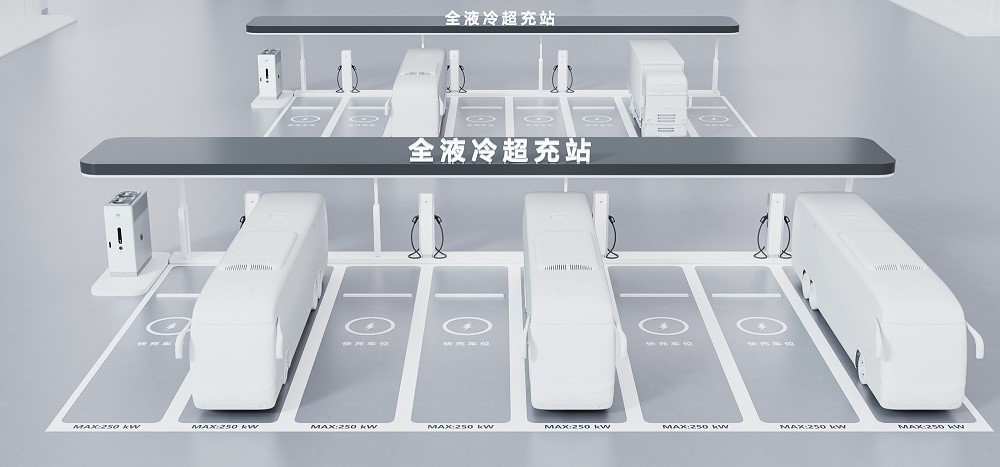While the global new energy vehicles are developing rapidly, the electrification process in the commercial vehicle field is relatively lagging behind, mainly limited by the lack of charging infrastructure and the bottleneck of energy replenishment efficiency. With its fully liquid-cooled ultra-fast charging technology, Huawei Digital Power is actively deploying supercharging networks, aiming to solve the problem of electrification of commercial vehicles and provide strong support for industry transformation.
1. Technological innovation: the advantages of fully liquid-cooled ultra-fast charging
Huawei's all-liquid-cooled ultra-fast charging technology adopts a fully liquid-cooled and fully modular design, which is high-tech, high-performance, and high-quality. Its fully liquid-cooled supercharging terminal has a single maximum output power of 600 kilowatts, a maximum output current of 600 amperes, and supports a charging range of 200 to 1000 volts, which can be compatible with various existing and future models, realizing the charging experience of "one kilometer per second", and bringing users the convenient feeling of "a cup of coffee, full power". In addition, the service life of the equipment is as long as 15 years, the failure rate is low, and it is "maintenance-free", which effectively reduces the operation and maintenance cost of the operator.
2. Strategic layout: Build a wide range of supercharging networks
Huawei Digital Power plans to accelerate the deployment of fully liquid-cooled ultra-fast charging piles across the country. According to Hou Jinlong, President of Huawei Digital Power, at the World New Energy Vehicle Conference in December 2023, Huawei plans to deploy more than 100,000 fully liquid-cooled ultra-fast charging piles in more than 340 cities and major highways across the country in 2024 to achieve "high-quality charging where there are roads." This strategic layout aims to meet the energy replenishment needs of commercial vehicles for long-distance transportation through a wide-coverage supercharging network, and promote the process of commercial vehicle electrification.

Figure: Commercial vehicle electrification breakthrough: Huawei has laid out more than 800km supercharging fast charging stations
3. Practical application: Shandong megawatt supercharging trunk line
Huawei's fully liquid-cooled ultra-fast charging technology has shown significant advantages in practical applications. In Shandong Province, for example, Huawei has helped build the world's first megawatt-level supercharging intercity logistics trunk line, and built 112 fully liquid-cooled supercharging stations in 16 cities across the province, forming a high-quality and high-coverage green freight logistics network. This project not only strengthens Linyi's position as a strong logistics city in the country, but also provides an important reference for promoting the construction of a demonstration zone for a strong transportation country in the country.
4. Industry Impact: Driving the Electrification of Commercial Vehicles
Huawei's supercharging network layout has a profound impact on the electrification transformation of the commercial vehicle industry. First of all, the efficient supercharging technology solves the problem of energy replenishment of commercial vehicles in long-distance transportation and lowers the operating threshold of electric commercial vehicles. Secondly, the extensive layout of the supercharging network provides solid infrastructure support for the electrification of commercial vehicles, and promotes the upgrading and improvement of charging infrastructure. In addition, Huawei's fully liquid-cooled ultra-fast charging technology is characterized by high performance and high reliability, which helps improve the service life and stability of charging equipment and reduce operating costs. However, the electrification of commercial vehicles still faces challenges, including the speed of construction of charging infrastructure, the harmonization of charging standards, and the balance of grid loads. Liu Dawei, President of Huawei's Digital Power Intelligent Charging Network Global Business Group, pointed out that charging is still the primary factor restricting the development of new energy vehicles, and the establishment of high-quality charging infrastructure represented by fully liquid-cooled ultra-fast charging is the key path to accelerate the rapid development of vehicle electrification.
5. International perspective: Global trends in the electrification of commercial vehicles
Globally, the electrification of commercial vehicles is progressing, but the construction of charging infrastructure remains a key challenge. For example, green corridors for electric trucks are being installed in Spain and Europe, requiring ultra-fast charging stations with at least 350-400 kilowatts of power, located in areas where trucks can be parked and drivers can rest. In addition, Siemens plans to spin off its EV charging business to boost growth in the fast-growing EV charging industry. These initiatives demonstrate the global focus on the electrification of commercial vehicles and the construction of charging infrastructure.
6. Future prospects: work together to build a high-quality charging ecosystem
Huawei Digital Power emphasized that building high-quality charging infrastructure requires the joint efforts of all parties in the industry chain, including parts companies, car companies, pile companies, operators, power grids, and governments. Through collaborative cooperation, we will accelerate technological innovation and equipment upgrading, promote the high-quality development of charging infrastructure, and provide strong support for the popularization of new energy vehicles and the electrification transformation of commercial vehicles.
To sum up, Huawei Digital Power's technological innovation and strategic layout in the field of fully liquid-cooled ultra-fast charging provide a feasible solution for the breakthrough of commercial vehicle electrification. With the continuous improvement and promotion of supercharging networks, the process of electrification of commercial vehicles is expected to accelerate towards a greener and more efficient future.






